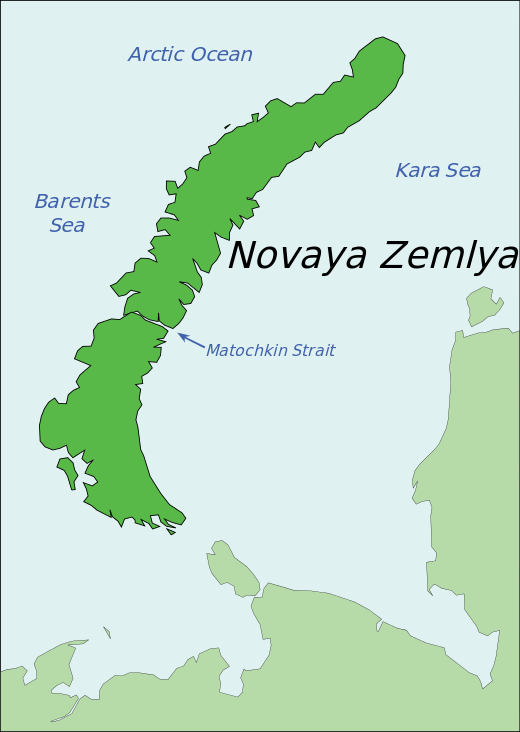I have often blogged about problems with disposing of nuclear waste in the United States. I have also occasionally blogged about problems that other countries have with nuclear waste. The only other country that has problems similar to the U.S. is Russia. Russia has thirty-five nuclear power reactors currently operating and is constructing a dozen more. In addition to disposing of spent nuclear fuel, Russia was also the site of major manufacturing of nuclear weapons during the Cold War and it has a great deal of nuclear pollution left over from that work. Russia does not have the technology to reprocess or recycle significant amounts of nuclear waste.
Novaya Zemlya is a group of islands in the Arctic Ocean between the Barents Sea and the Kara Sea in Northern Russia. The U.S.S.R. tested nuclear bombs on the islands between 1955 and 1990. During its use as a nuclear test site, there were two hundred and twenty-four detonations. Novaya Zemlya was used as a site to bury some liquid and solid radioactive wastes until 1992 and the islands are already contaminated from the fallout of all the bombs tested there so burying more waste would not threaten the environment.
Now an official with the Russia Arctic nature reserve has renewed suggestions that the islands be used for the storage of nuclear waste. Novaya Zemlya could be a place where large amounts of waste could be stored while Russia develops the technology needed to reprocess or recycle. Using Novaya Zemlya for nuclear waste storage has been suggested in the past but the cost and difficulty of transporting all that waste to Novaya Zemlya were considered prohibitive.
Last year, the regional government for Novaya Zemlya approved a plan to start digging a new repository on the islands for low and intermediate level nuclear waste but concerns about global warming are raising questions about the wisdom of such a project. Novaya Zemlya is covered in permafrost which was supposed to trap radioactive materials but now winter temperatures are rising above freezing which threatens to melt the permafrost.
Rosatom, the big Russian-owned nuclear company, is now looking at some other possible sites for storage of nuclear waste. One possible choice is Sosnovy Bor, which is the site of the Leningrad Nuclear Power Plant and is located near St. Petersburg. The soil conditions are good for such a repository and there is ample need but there is also a well organized anti-nuclear movement which is opposing both the construction of a new Leningrad Nuclear Power Plant as well as any plans for storing nuclear waste there.
Another possible new site for Russian nuclear waste is the Murmansk region. The Kola Nuclear Power Plant and Atomflot, the port for Russian nuclear icebreakers, are located in Murmansk. Murmansk appears to be the first choice for Rosatom but there is local opposition. Critics of the plan say that Murmansk does not really need a local repository for nuclear waste. There is less organized resistance to nuclear projects in Murmansk than Sosnovy Bor, but the geology is not as good for digging a repository. The ground is mostly rock and any digging would have to include extensive blasting.
Although the need for a new repository for nuclear waste is great, there are enough problems with the three sites that are being considered that it may take years to actually begin construction of a repository.
